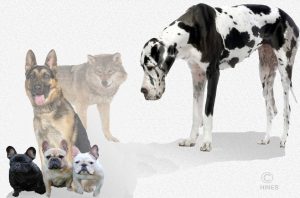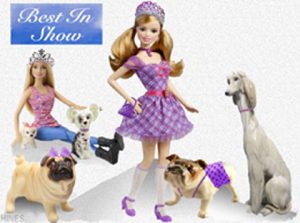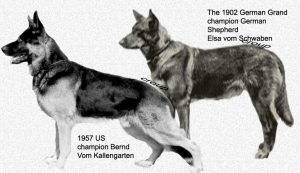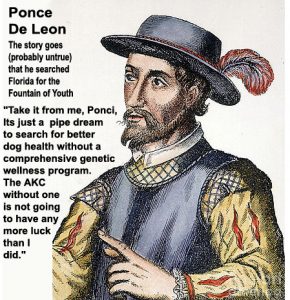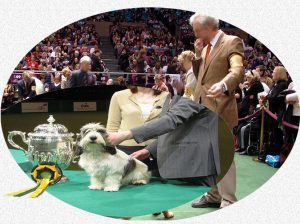Ron Hines DVM PhD
Ninety percent of the emails I receive are from dog and cat owners facing a health issue in their loved companions. I give them what guidance I can. For them and probably for you, this article is of no immediate benefit. But when you contemplate getting your next dog or cat, this article might be of help. I want you to know that the genes that come with your next pet are as important to its long-term health as is the home you make for it, what you feed it, the amount of love you give it and the veterinary care it receives. For many of the problems that occupy the time of a distance veterinarian like me, they are the most important – no one writes to me with simple problems.
No amount of veterinary skill can change your pet’s genetic predisposition to certain health problems. No medication will. No supplement will. No amount of money spent will. Affection and a loving home will make your pet happy and might even extend its life; but we all face Destiny at some point and, to a large degree, that destiny is written in our genes. Domestic dogs are the most genetically diverse of all animal species. That is entirely our doing. Through selective breeding, we alter their genes to make them large and intimidating, to make them tiny and cuddly, or to make them look as little like the dogs of the past as we can.
We veterinarians have always known that the more genetic tinkering a breed has experienced since its archetype ancestor (the wolf at the top of the photo), the more likely it is to have specific health issues. Veterinarians also know that breeds and families within a breed (bloodlines) that are as highly inbred as many fad breeds are – have even more than their fair share of health issues. (read here) I mentioned that dogs are the most phenotypically diverse (how they look) creatures on our planet. Those differences extend to the diseases that affect them, their temperament and their potential life spans as well. (read here)
Dogs As Fashion Accessories
If you exclude the true working and task dogs that are sold for their particular abilities, members of the dog breeding industry make their money selling dogs that visually appeal to the public. The AKC in their canine Miss America shows takes the lead in promoting those visual Barbie Doll breeds. (read here) You notice that health and longevity are never mentioned. As in any profit-driven enterprise, the new and unique, the rare and striking, the Hollywood darlings and the fashion statements sell and command the highest prices. Inconvenient negative factors (like “Barbie, how are you going to get food through that narrow waist of yours and why can’t you touch your toes ?” or “How’s that fashion accessory pet of yours going to breathe through its squished in nose?”) are glossed over or conveniently omitted from the sales pitch. In that respect, the AKC is no different from the cosmetics industry. (read here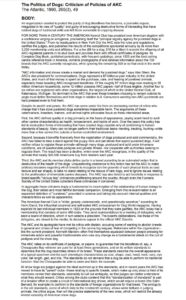 & here) As in all beauty pageants, health, temperament and situational suitability are trivial matters to be ignored when AKC judges choose their champions. (read here
& here) As in all beauty pageants, health, temperament and situational suitability are trivial matters to be ignored when AKC judges choose their champions. (read here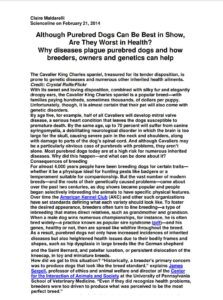 & here
& here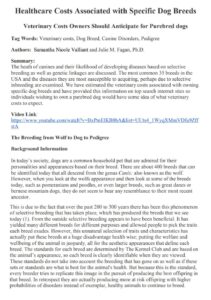 )
)

Insurance companies don’t make money unless they have a perceptive understanding of risk. They need to know very accurately what the chances are of something occurring in a given population in a given location. The Nationwide Insurance Company sells a lot of pet health insurance. To price their policies in a way that nets the Company profits but does not drive away customers with higher-than-required premiums, Nationwide’s underwriters and actuaries not only need to know your pet’s medical history, environment and age; they needed to know what the likelihood is that your dog’s specific breed will cause it to develop a specific diseases. So, in 2007, they began analyzing which diseases were most common in which breeds of the dogs owned by their policy clients. Over a 9-year period, they analyzed the health records and claims reimbursements of 1.27 million dogs. You can read a portion of that study here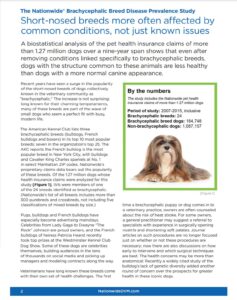 . They concentrated on the health differences between snub-nosed breed and breeds with normal canine face conformation. What stood out in the results was that brachiocephalic breeds – the ones with short noses and bulging eyes – had more health issues than breeds with longer noses and mix-breed dogs. The longer nosed breed also lived longer. I want to explain a bit about the specific genetically- based health problems that they found:
. They concentrated on the health differences between snub-nosed breed and breeds with normal canine face conformation. What stood out in the results was that brachiocephalic breeds – the ones with short noses and bulging eyes – had more health issues than breeds with longer noses and mix-breed dogs. The longer nosed breed also lived longer. I want to explain a bit about the specific genetically- based health problems that they found:
Breathing Issues
All short-nosed dogs have difficulty inflating their lungs. Their lungs and diaphragm are anatomically fine; but due to their shortened faces, the passages that air must travel to reach their lungs are defective. In some, their breathing difficulties are quite obvious; in others they are only perceptible during strenuous exercise or on hot days (dogs rely on rapidly exhaling and inhaling air = panting to keep cool). These flat-faced breeds tend to have narrowed passages (airways) that lead to their lungs. Some of that is due to flabby and smaller than normal nostrils (stenotic nares). That is often combined with a floppy soft palate left too long for their flattened faces. In some, their windpipe (trachea) is also narrow or flabby (although that is a common problem in many small breeds like Chihuahuas and Pomeranians as well). With advancing age, just like our flabby chins and wrinkles, the lining of the larynx budges inward making breathing ever more difficult (everted laryngeal saccules). That is a progressive problem that can eventually lead to laryngeal collapse. (read here) These problems are sometimes called Brachycephalic Obstructive Airway Syndrome or BOAS. Your veterinarian can attempt corrective surgery for some of those problems. Extra tissue obstructing their nostrils can be amputated. When these dogs are more comfortable breathing with their mouth open, remodeling their nose with this plastic surgery is often quite successful. But when an open mouth causes no noticeable improvement, the problems probably extend farther down the respiratory channel. Surgery must then be considerably more extensive and the outcomes are much harder to predict. Further hints of problems deeper within the respiratory channel are a persistent inclination to gag and attempts to vomit. You can read about these problems in detail here & here.
Eye problems
“Let the Lion Dog (Pekingese) be small. Let its face be black, its forefront shaggy and its forehead straight and low. Let it be dainty in its food so that it shall be known as an Imperial dog by its fastidiousness; sharks fins and curlew livers and the breasts of quails, on these may it be fed; and for drink, give it the tea that is brewed from the spring buds of the shrub that grow in Hankow, or the milk of the antelopes that pasture in the Imperial parks. Let its eyes be large and luminous; let its ears be set like the sails of a war junk; let its nose be like that of the monkey god of the Hindus. Let its forelegs be bent; so that it shall not desire to wander far, or leave the Imperial precincts. Let it be lively that it may afford entertainment by its gambols; let it be timid that it may not involve itself in danger; let it be domestic in its habits that it may live in amity with the other beasts, fishes or birds that find protection in the Imperial Palace. Let its feet be tufted with plentiful hair that its footfall may be soundless. And if it falls ill, “anoint it with the clarified fat of a snow leopard’s leg and, in a thrush’s eggshell, give it to drink the juice of custard apples, into which are added three pinches of shredded rhinoceros horns, and apply piebald leeches; and if it dies, remember that man is not immortal and thou too must die”.The Chinese dowager empress Cixi
Some people still believe that short nosed (brachycephalic) dogs were developed for blood sports. That their short noses give them an advantage in the dog fighting ring. (read here) I do not know if there is any truth to that. But I do know that the real reason short-nosed breeds are so popular today relates more to something very deeply rooted in our psychology – something basic to the human species. It is etched in the genetic templates of our minds. We all find faces that resemble a human infant appealing and beckoning. We are drawn to their big, wide set eyes, their cute stubby nose, their wide rounded head and the lower position of their eyes. We are not only drawn to them by their adorable faces; their plump body conformation and short legs are also points of endearment. Just gazing at these creatures elevates our emotions, lowers our stress level and gives us a general feeling of well-being. They beckon for our protection. Who could pass such a cutie by? As with human infants, they tug on the heartstrings of women more than men. It is something most of us are just genetically pre-programmed to do. Cartoon animators figured that out long ago. So perhaps it’s not just limited apartment space that makes stubby nosed dogs the most popular breeds in New York City and Los Angeles. Perhaps they help combat the increased everyday stress that is inherent in living in those intense urban environments. These are just my thoughts, there are others. (read here)
The downside of that cute face is a skull structure that forces the pet’s eyes into a bulging (exophthalmic), unprotected position. Injured corneas are one of the most common reasons these pets visit me. In younger animals, the corneal damage is often due to bumping into objects (no nose for a bumper guard). But as time goes by, their abnormal eye conformation no longer permits the centers of their corneas to be bathed with sufficient protective tears. Tears are a major source of the cornea’s oxygen, antibodies and nutrients. Tears also rely on an oily constituent secreted by glands on the eyelids (meibomian glands) to keep the tears from evaporating. No one knows if those glands function normally in short-nosed breeds, but hairs and debris present in the nasal folds of snub-nosed dogs irritate the eyelids and make the situation worse. You can read all about those problems here. A similar lack of adequate tear protection (exposure keratoconjunctivitis aka evaporative dry eye) occurs in people with budging eyes; particularly folks with hyperthyroidism. (read here)
Skin Problems
The skin folds on a pooch’s face and body are cute. But in both places, they are locations for fungus and bacteria to prosper. They trap moisture and debris (read here) and hair on one side of these folds rubbing against skin on the other is a chronic irritation. The types of skin infections these folds produce are called intertriginous dermatitis. (read here)
But I believe there is a second underlying, generalized, skin problem at work here as well. When shar-pei dogs became popular pets, I noticed in vaccinating them that their wrinkly skin offered no resistance to my needle. Their skin was as soft as butter. I believe that the skin ultrastructure of these dogs, and other wrinkled dogs, is defective; possibly in the amount or character of its collagen. Wrinkly mice (nude mice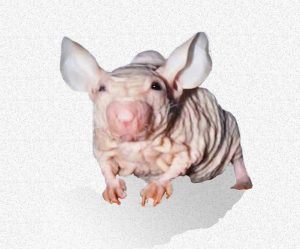 ) suffer similar defects – and when they do, other internal parts of their bodies are deficient in collagen. Read about that here, here & here.
) suffer similar defects – and when they do, other internal parts of their bodies are deficient in collagen. Read about that here, here & here.
In dogs, hot spots, ear infections, musty skin odor and anal sac disease are the more obvious results. Compounding the problem is the moderately increased presence of allergic skin disease in short-nosed breeds that was confirmed in the Nationwide study. Allergic scratching makes the effects of their underlying skin defects worse. Repeated courses of antibiotics bring MRSA bacteria into the house. Less obvious in the wrinkly breeds, but also present are immune deficiencies that make them more susceptible to things like demodectic mange. (read here & here)
Internal Affairs: Abdominal Issues
The Nationwide study that I referred to earlier lists digestive and urinary tract issues as being higher in short faced dogs than in the general dog population. I am not certain that that can be pinned on their genetics. As the Chinese empress decreed, these small dogs are easily spoiled into eating an inappropriate unbalanced diet. Also, many of these small dogs live in household settings that do not allow frequent enough opportunities to urinate. Until those sorts of factors are considered, it is a bit of a stretch to blame those digestive and urinary problems on their short noses.
Internal Affairs: Heart & Lung Issues
In the same Nationwide study, short-nosed breeds were at a considerably higher risk of pneumonia. Perhaps their elongated soft palates put them at a higher rate of accidentally inhaling their food or water. But increased effort in taking a breath (dyspnea) damages the lungs over time too. A similar situation of difficult inhalation (tracheobronchomalacia) is a rare genetic disease of children. Normal lung development in infants of all species requires that the lungs properly inflate from birth. That is not occurring in dogs born with breathing obstructions that often extend into their tracheas (windpipes).
Perhaps other heart/lung-related problems increased in these short-nosed dogs as well. But the Nationwide data was not presented in a way that would allow for valid conclusions about that. Long and short-nosed dogs of equal size were not compared and age was not factored in. The chances for heart failure increases with age. Longer nosed dogs tend to live longer than the shorter nosed breeds and many of the shorter nosed ones might have passed away from other health problems before their hearts gave out. But veterinarians who believe that brachycephalic dogs suffer more from heart issues suggest that a deficiency of oxygen over time (chronic hypoxia) causes blood channels in the lungs to narrow (pulmonary vasoconstriction) which then leads to increased blood pressure within the heart (pulmonary hypertension), a known risk for heart failure. (read here) Where you live (urban vs rural/suburban) influences the prevalence of heart issues in pet owners (carbon monoxide, air pollution, etc.) why not in their pets as well? The owners of short-nosed dogs tend to live in urban areas. The fact that the more well-to-do owners of short-nosed dogs are already more accustomed to frequent veterinary visits and the greater sophistication of veterinarians in large cities could also have skewed the findings. If you don’t look for problems, you generally find fewer of them.
OK, You Listed The Problems Of Short-nosed Dogs What About Other Extremes?
Dogs and humans have shared living quarters for, perhaps 30,000 years. (read here) At first, these wolf dogs looked quite the same as their wild cousins – the changes were inside, in their personalities and ability to coexist with a different species. The next changes were probably in their diet and nutritional needs. Humans were eating considerably more carbohydrates than these dog wolves were used to, so as their genetics evolved to their new situation, their ability to digest carbohydrates increased. (read here & here)
Other changes also began early – although ancient skeletons indicate that the animals remained about the same size as wolves for many generations. Eventually, though, humans found that individuals with mutant genes that made them larger or faster than wild wolves were better at hunting and that dogs with genes that gave them herding tendencies were valuable too. Those domestication and agrarian changes that forged a union between dogs and man happened long ago. It is only for the last 300 years or so that humans have been fiddling with canine shapes and personalities for more trivial reasons. And doing so with utter disregard for the other effects that those genetic changes might produce. Today, we have over 350 dog breeds, each with its own unique genetic make up – greater genetic diversity than any other land creature living now or extinct. As I write this article, your dog might be about 9000 dog generations away from its wolf dog ancestors that wandered into some primitive human habitation so long ago. (read here) The introduction of a new (ie mutant) gene – like coat color – can be an entirely benign (harmless) event. But sometimes it is not. That is because some genes have multiple functions. (read here)
Genes sometimes transfer in groups – the one you were breeding for brings along unseen fellow travelers (other genes) residing next door on the chromosome. Things can get complex and unpredictable when you tamper with genetics. (read here)
The unintended consequence of a single gene change pale in comparison to the negative health consequences of the intensive inbreeding required to produce the extreme physical features of the fad breeds of today. When dog breeders take that road, each individual in the breed is too closely related to the other members of the breed. Most harmful genes are recessive genes. They only cause their health damage when both the (normal looking) mother and father of the pup carry a single bad one and a single good one and the offspring ends up getting a pair of two bad ones. The closer the parents are related, the more likely it is that both parents will be carriers of the same bad gene. Another way that sad situation occurs is when some dog, somewhere, wins ribbons for some novel body appearance at some AKC dog show. It then suddenly becomes the “service stud of the hour”. Then its genes (the good and the bad) are spread far and wide throughout that breed.
Let me tell you about Max…. In 1925, Max Von Stephanitz, the developer of the German shepherd, became concerned about his breeding project. As a result of Max’s inbreeding techniques, his dogs, were being born unable to develop a full set of adult teeth. Their legs were also getting shorter, giving them a square, boxy appearance they did not have in earlier generations. But what concerned him most was that his dogs were no longer winning shows. Knowing a bit about genetics, he knew he needed to introduce new blood into his dog kennel. Searching for the type of dog that fit his mental image of what he thought might win the German shows, he settled on a stud dog (Klodo von Boxberg) to introduce that new blood. Klodo was a dog with a quite different body type. He had a deeper chest, crouching butt as-if-to-launch position (“steep croup”) and a longer body. But most unfortunately, the dog had a distinctive “far-reaching” hackneyed gait. A way of trotting with exaggeratedly high knee and hock action due to abnormally flexible joints. Something Max thought would be eye catching. He was right. Klodo became the talk of the town. There were a lot of trans-Atlantic shipments of stud dogs in those days; everyone wanted Klodo and his sons to father their litters and the dog’s genes quickly established themselves in North America. You can’t blame Max for not knowing, polygenetic traits were unknown at the time; but in selecting Klodo, he selected for some very undesirable gene combinations that favored joint problems like hip dysplasia and cruciate ligament ruptures.
Today, the AKC (for reasons not known to me) sees that sort of gait as a positive only in miniature pinchers. The AKC will tell you that they work diligently to weed out bad genes. (They have as much chance of doing that with their current policies as Ponce De Leon had of finding his pipe dream – the fountain of youth – unless they consent to relaxing breed standards, educating their judges and admitting that many of those standards are actually deformities.) I can’t tell you about all the breed-related health issues one might anticipate. There are far too many of them – all based on silly, stylish breed conformation rules that prove injurious to a pet’s general health and lifespan. Besides, the AKC provides me with a steady stream of new ones. Some are mentioned in the (ref)s I scattered throughout this article. The rest can be found in the NCBI and PubMed index – God bless them for providing us all with that service. Many of the genetic problems of dogs that have resulted from inbreeding are poorly characterized and the genetic errors underlying them are still unknown.
Largeness – The Larger-Than-Life Attraction
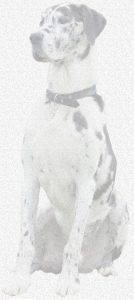
Nationwide Insurance Company also ran a study among its dog policyholders in 2016. It examined a particular form of cancer that affects the bone. They found that it occurred considerably more frequently in the large and giant dog breeds. (read here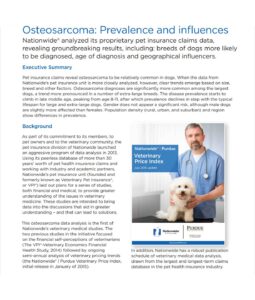 ) When a dog breeder selects a line of dogs to be larger or smaller than a medium size dog, he/she is choosing a group of genes that favor large or small and discarding the others. The Nationwide study found that a tumor of the bone, osteosarcoma, was considerably more common in the very large (giant) breeds. Among those breeds, some had higher levels than others and greyhounds and certain retrievers that are not giant breeds also suffered these tumors more. (read here) Like hip dysplasia in German Shepherds, it is gene combinations, not a single gene, that determine the dogs most likely to develop these tumors. (read here)
) When a dog breeder selects a line of dogs to be larger or smaller than a medium size dog, he/she is choosing a group of genes that favor large or small and discarding the others. The Nationwide study found that a tumor of the bone, osteosarcoma, was considerably more common in the very large (giant) breeds. Among those breeds, some had higher levels than others and greyhounds and certain retrievers that are not giant breeds also suffered these tumors more. (read here) Like hip dysplasia in German Shepherds, it is gene combinations, not a single gene, that determine the dogs most likely to develop these tumors. (read here)
To understand why giant breeds develop this tumor more frequently than dogs of ordinary size, we have to understand what makes them so large. When giant breed pups are born, they aren’t much larger than ordinary size dog puppies. But they quickly begin to grow more rapidly than ordinary ones. Two of their hormones interplay as the cause of that. The first is growth hormone (GH), produced by your dog’s pituitary gland, a small pea-shaped organ at the base of its brain.
The second is Insulin-like growth factor 1 (IGF-1). produced mainly in the pet’s liver. High levels of growth hormone circulating in the pet’s blood stimulate the production of IGF 1. That growth hormone level and IGF-1 are higher throughout life in human giants has been verified. That they are higher throughout life in giant dogs has not. But it is assumed to be so. High levels of GH stimulate cells to divide more frequently and more frequent cell division (mitogenesis) is a known driver of cancer. The number of osteosarcomas that occur in medium size dogs is probably the norm. However, the small and toy breeds have less of that tumor type than one would expect. They seem to be somehow protected. Who gets which tumor and when is a complex process in which many factors interplay – genes, lifestyle, nutrition, etc. You can see from the Nationwide study that even among the giant breeds, some experience these tumors more frequently than others. (read here)There are other health issues that affect the giant breeds more than the general dog population. The number one cause of death in Great Danes is said to be stomach bloat (gastric bloat). Another problem these large breeds suffer from is a form of heart disease called cardiomyopathy. Those issues and a general speed up of the aging process are what account for their shorter lifespans. Some suspect that their high growth-driving hormone levels are the cause. No one knows for sure if increased growth hormone levels are the underlying cause of any of these other problems. Humans with excess growth hormones tend to have shorter lives as well, and their GH excess has been attributed to their increased risk of heart disease. Most veterinarians associate the giant breed’s susceptibility to bloat to their deep chest. But stomach emptying is also influenced by the hormone, ghrelin, whose production is tied to blood growth hormone levels. (read here & here)
What About The Largest Members Within A Breed?
Larger than life within an individual breed is also eye catching. It has been my experience over the years that working breed dogs that are on the top end of their breed standard weight also have more health issues and shorter lives (bigger in frame, not overweight). I do not know the reason. Thinking back, it was often heart, hip and knee health issues that they faced. The opposite is true for the toy breeds. The smallest ones within their breed tend to face the most health issues. Read about one of those small-breed issues here.
Well, If The AVMA, The AKC And HSUS Know All This Why Does It Continue To Happen?
“Study groups”, public pronouncements and platitudes to the contrary, groups like the AVMA and the AKC that should be the guardians of canine and feline health almost never are. These groups are under pressure from cash-focused breeder lobbies and perhaps the perverted assumption that breed-related health problems constitute an important veterinary revenue stream. I suppose it is naive to expect otherwise. It is not that all the sins of the dog breeding industry can be laid at the AVMA’s doorstep. They are just one weak, highly bureaucratic and amoral organization among many much more powerful moneyed interests that pander to the very basic human craving for the unusual, the fresh and the new. Empathy for animals and moral fiber play no part in the AVMA decision. Their stances on over-vaccination, early age neutering and telemedicine are no better. Rich national humane societies that claim to look out for the interests of dogs are no better, they tend to primarily look out for themselves. see here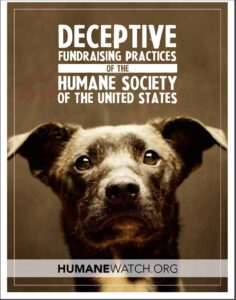
If you don’t like your $9.95 Barbie, you can toss her away. But what will happen when veterinary care for a fashion statement dog or cat becomes more than you can afford? Cruelty can be deceptively stylish. So, it is up to individuals like you to spread the Good Word – it’s the mutts, the alley cats, the working dogs and the centuries old tried-and-true that are the diamonds of the companion animal kingdom.
Scottie Westfall, The Retriever Man, presented the same point in another way :
“The biggest welfare problems that dogs face today in the West are not neglect, dog fighting, or puppy mills. The biggest welfare problems they face are distortions in conformation that have very real consequences for their health. The reason why this is such a big welfare problem is that it’s not seen as being objectively cruel like those other practices. Dogs [and dolls] win prizes because they have a particular conformation, even if it is very bad for them.”
You are on the Vetspace animal health website
Visiting the products that you see displayed on this website help pay the cost of keeping these articles on the Internet.

